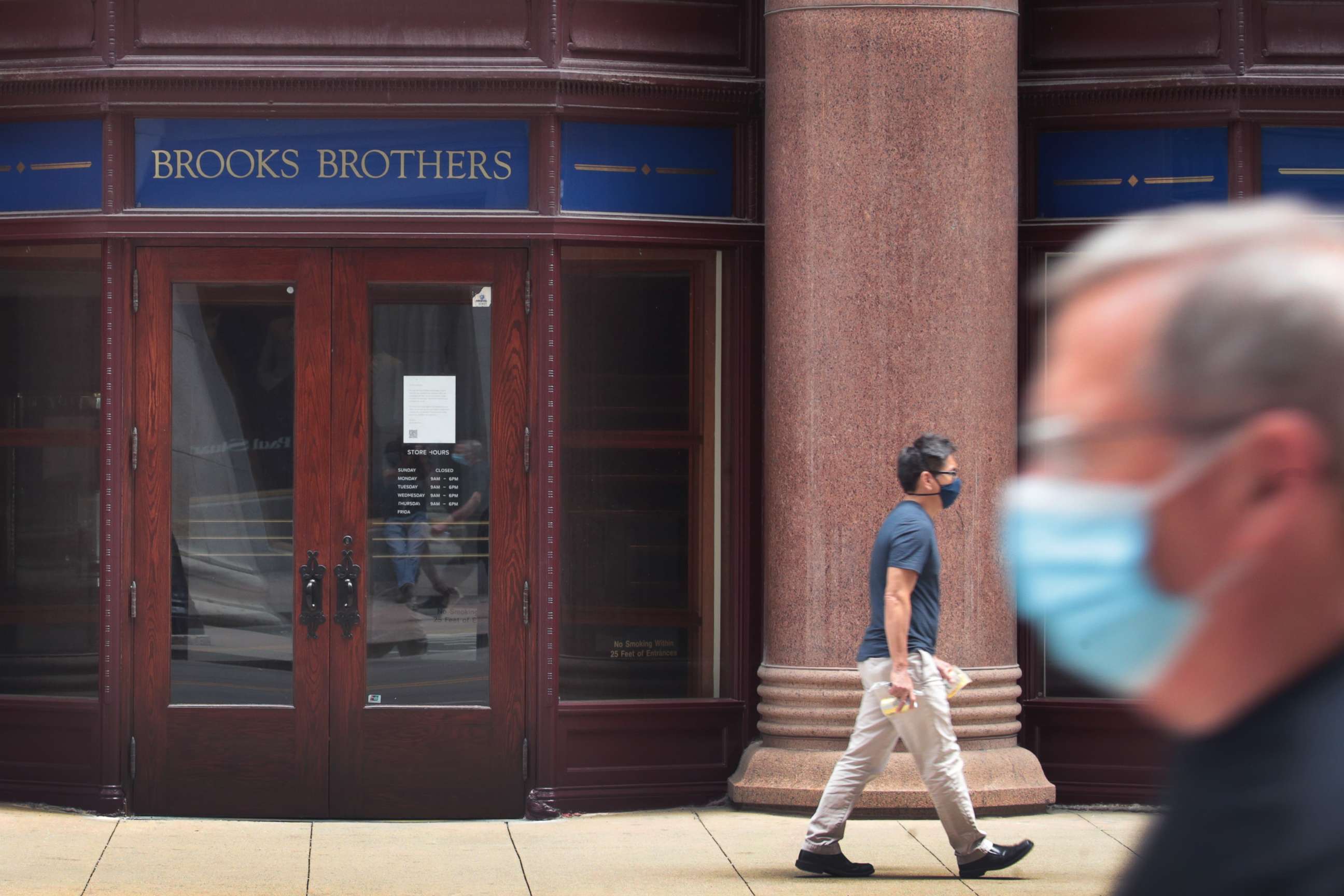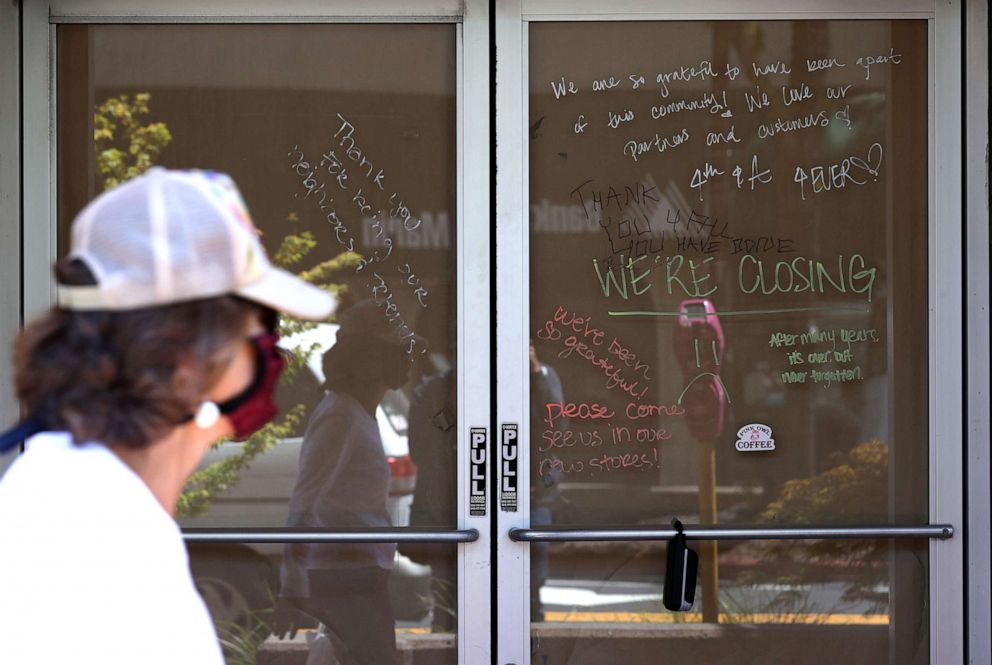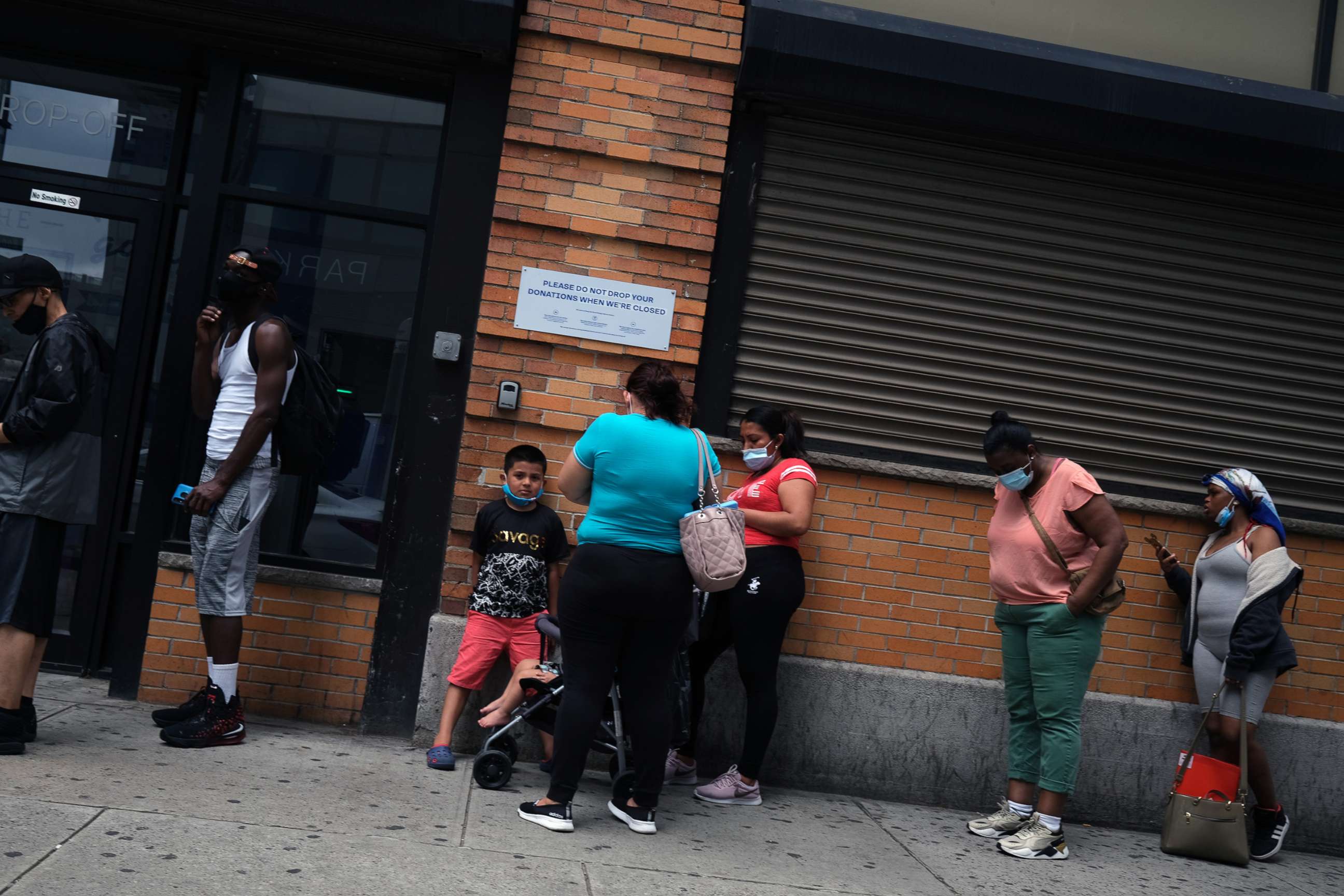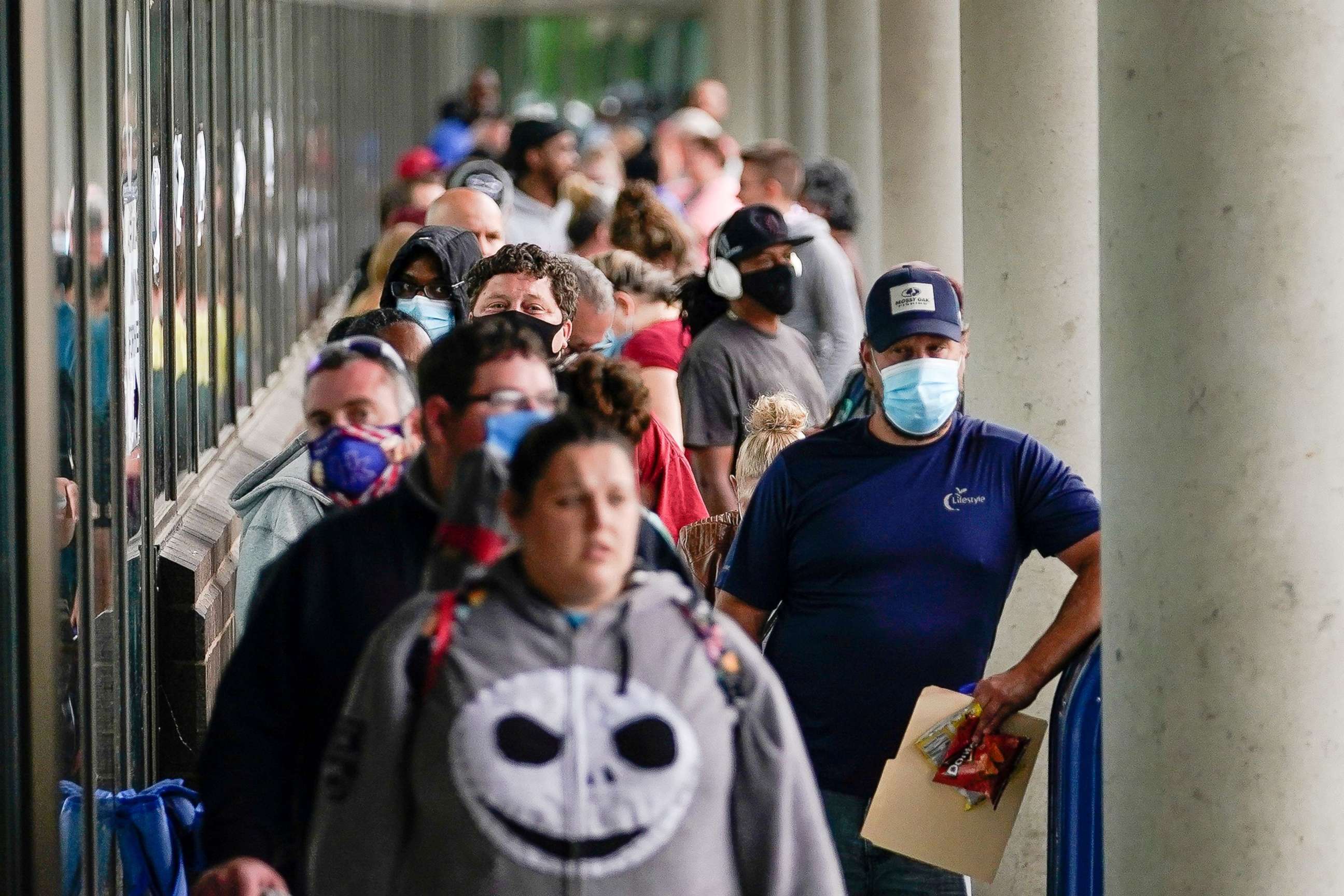As COVID-19 financial crisis wages on, some economists warn of a divergent 'K-shaped' economic recovery
The pandemic has sent some businesses booming and others belly-up.
Economic recoveries come in all sorts of shapes -- V, W and L -- and amid the economic devastation of the coronavirus pandemic, there has been copious debate about how the U.S. economy will bounce back.
One of the newer and more troubling theories that has gained traction in recent months is the K-shaped recovery, where things get better for the haves, and worse for the have-nots, experts warn.
"I call it the K-shaped recovery because for some it’s been a sharp rebound for others it’s been a continuing decline," Peter Atwater, an adjunct lecturer in the economics department at William & Mary, who is credited for coining the "K-shape" theory, told ABC News.
In many ways, a K-shaped recovery highlights the divergent experiences of individuals with coronavirus, where white-collar workers are able to work from home in many cases, to continue seamlessly with their jobs and potentially avoiding exposure to the virus and essential workers, many of who do not have benefits and cash safety nets, have to report to a physical location, Atwater said.
The bigger and more cash-rich businesses and individuals appear to be faring better in many cases, while those who are poorer are not only finding themselves out of work but disproportionately affected by the virus itself.
For a handful of already-struggling retailers, the COVID-19 financial crisis brought closures and bankruptcy. Brooks Brothers, J.C. Penney, J. Crew, Pier 1, Neiman Marcus have all filed for bankruptcy in recent months, and the list is growing as the pandemic rages.

And these are among the bigger, more established companies. An April report from the Federal Reserve Bank of New York found that 17% of small businesses would have to permanently close if faced with a two-month revenue loss.
Bank of America analysts also noted divergences in recovery in a July report, writing that large chains with capital advantages have "largely recovered to prior year spending while the rest of their industry remains pressured." Their data shows a 20% gap in spending between large chains and smaller, independent firms -- recommending investors to look towards the larger chains.
Meanwhile, for many behemoths of the global business world, their recovery path has actually already brought new gains. Some stocks, including Amazon and Tesla, have reached new, record highs even as the rest of the economy recedes. The stock market at large has also been out of sync with the rest of the economy.
“Some of the more extreme divergences, if you look at a company like Tesla whose stock has just exploded higher and all of the FANG [Facebook, Amazon, Netflix, Google] stocks have done extremely well,” he said. “There seems to be a sense that these companies are completely inoculated from whatever the pandemic is bringing forth.”

Uneven recovery for both companies and individuals
The K-shape recovery "makes a lot of sense in this situation," Dante DeAntonio, a senior economist at Moody’s Analytics, told ABC News. "You’ve already seen that."
"The Amazons, the Googles and the Facebooks of the world felt very little impact," he said. "Their impact is much smaller already and they are likely to rebound more quickly."
DeAntonio noted that size and cash available "go hand-in-hand with adjusting to this new normal" and adjusting to the ever-changing pandemic restrictions even as re-openings happen.
Atwater added that firms that have done well during the pandemic "tend to be extremely large" and have "either directly or indirectly been beneficiaries of the programs that the Federal Reserve implemented immediately following the market crash in March," Atwater noted. The Fed has pulled out all the stops to ameliorate the economy, purchasing massive amounts of securities to support financial markets, slashing interest rates to near-zero, and establishing direct-lending programs to major corporate employers, among other things.
While size and access to cash are big factors for which businesses are able to weather the pandemic, some businesses such as Zoom, Clorox and Amazon also had unique advantages in that demand for their goods or services soared as a result of the outbreak and stay-at-home mandates.
"Smaller businesses, for the most part, have been very reliant on the fiscal policy initiatives that the government itself did," Atwater added, referencing the problem-plagued Paycheck Protection Program loan program. "But what you see is that while they may have been sustained, their underlying businesses, many of them remain highly jeopardized."
“If we look at companies, big multinational companies, particular those closest to the liquidity of the Federal Reserve, they have done extremely well, while smaller businesses have not,” he said. “We’re seeing for both companies and individuals a very similar experience.”
Initially, the "mid-March panic" -- when the first impacts of lockdowns and the pandemic on the economy took place -- "was a very uniform experience," according to Atwater.
"Everyone felt similarly about the outbreak and you saw that in any number of metrics, but what we started to see after that were very different individual experiences," he said.
“People who worked from home their level of confidence rebounded very quickly and in many ways the sense that I got was that while people were concerned by the outbreak, they were more inconvenienced by it," he added. "Life went on very consistently with what they had been experiencing earlier."
"For people who didn’t work from home though, it was a very different experience and so what you saw were whether it was small businesses, restaurants, people in the service industry, the outbreak was a very traumatic event," he added. "And things didn’t recover, in fact things continued to get worse."
In addition to the financial hardships, many essential workers during the pandemic also risked exposure to the disease just by showing up for their jobs while others were able to telework.
"For many people there is this concern that what they thought was a temporary event in March has a far greater amount of permanence to it," he said. "So instead of being furloughed they are now expecting to be laid off all together."

Recovery should focus on the unemployed
Heidi Shierholz, the former chief economist at the U.S. Department of Labor and current senior economist at the Economic Policy Institute, cautioned that there is still so much uncertainty when it comes to predicting the recovery, but what's starting to become apparent is that a lot of jobs that were lost are not coming back any time soon.
"There’s never been more uncertainty about trying to predict where things are going because there are so many more moving parts," Shierholz told ABC News.
Atwater, DeAntonio and Shierholz all noted that the "V-shape" recovery many were hoping for early on is likely not in the picture at this point, and a full economic recovery remains largely contingent on a vaccine or effective treatment for COVID-19.
Shierholz noted that the ongoing layoffs, which have decreased since peaking at 6.9 million unemployment claims one week at the end of March, are still over a million each week or "twice the worst week of the Great Recession."
"Businesses that thought they could hold onto their workers and tried to because they were also thinking in those terms are now realizing, 'Oh it's not coming back the way it was, it's not going to be business as normal again,'" she said.
Historically in recessions, about 70% of temporary layoffs end up being permanent, Shierholz added.
Since the pandemic began, more than 47 million Americans have lost their jobs and filed for unemployment insurance at some point. As of July 9, some 18 million U.S. workers are still receiving unemployment insurance, according to the Bureau of Labor Statistics, but experts cautioned these figures might not capture the anguish of business re-closings as the pandemic wages on.
She said that divergent recovery experiences "happen in all recessions" and while it is "happening for sure now," she said that it's "not two equal paths that are splitting" but rather it's a much smaller share of the economy that is booming back.
"The top part of the K, the places that really will have the extravagant V-shape" recovery is just a "small share" of the economy as a whole, according to Shierholz.
Shierholz recommends that federal recovery efforts should focus on state and local government aid and unemployment insurance. One of the biggest barriers to recovery following the Great Recession was consumer demand was low -- hence the need for cash flow to the millions who have been forced out of work due to the pandemic.
When demand is low, it becomes a "vicious cycle" that leads to firms producing fewer goods and services and more secondary layoffs, she said.
How Congress acts with the next economic relief and recovery packages "will really dictate the strength of the recovery," Shierholz added. "It absolutely matters to real peoples' lives in the next several years."

For DeAntonio, the mounting uncertainty and so many moving parts mean that "any little thing could make a big difference" when it comes to recovery.
"I think we need to make sure that money keeps flowing to the 10 million people who are still sitting around unemployed, who are slowly spending some money now because they're getting that assistance," he said, referencing the additional $600 a week in pandemic unemployment insurance, that is set to expire at the end of the month.
"Whereas if that gets cut off, you're gonna see a huge drop off in consumer spending, which has the potential to filter through and cause a worse reaction in the economy because businesses that are sort of hanging on by a thread now only be hurt more if consumers have to pull back even further on their spending," he said.




